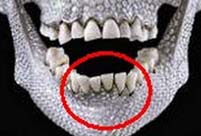 Deng Xiaoping: 'I have a clear conscience all my life'
Deng Xiaoping: 'I have a clear conscience all my life'
 Xi Jinping: 'The people are our strength'
Xi Jinping: 'The people are our strength'
 Amazing cliff diving in cold winter
Amazing cliff diving in cold winter
 Enjoy Sochi 2014 in slow motion
Enjoy Sochi 2014 in slow motion
 University student sentenced to death for poisoning roommate
University student sentenced to death for poisoning roommate
 Chinese lunar New Year celebrated in San Francisco
Chinese lunar New Year celebrated in San Francisco
 Taiwan Lantern Festival 2014
Taiwan Lantern Festival 2014
 Haiyang Yangge: make up
Haiyang Yangge: make up
 China's top 10 richest cities
China's top 10 richest cities
 |
| A visitor watches a piece of 3D printing work in a gallery in Amsterdam, the Netherlands on April 23, 2013. (Xinhua Photo) |
3D printing, once seen as a possible trigger of a third industrial revolution, is losing some of its gloss in the eyes of some 3D printer producers, faced with shrinking sales.
Hype and attention on consumer 3D printing is ramping up. However, the technology is still at the stage of initiation and development. It would be unrealistic to expect the obvious commercial impact to be immediate.
It seems that Jeremy Rifkin’s pronouncement on new digital manufacture may have been overstated by the media.
"Internet technology and renewable energies are beginning to merge to create a new infrastructure for a Third Industrial Revolution that will change the way power is distributed in the 21st century."
In a McKinsey Global Institute list of twelve technologies with the potential to create economic revolution, 3D printing ranks only nine, after technologies such as mobile internet, automation of knowledge work, the internet of things, cloud technology, advanced robotics and autonomous vehicles.
The global management consulting firm estimates the potential economic impact of mobile internet will be 3.7 -10.8 trillion US dollars per annum by 2025, while the forecast for 3D printing is an annual 0.2–0.6 trillion US dollars. Therefore, it seems like something of a media illusion to equate 3D printing technology with a "third industrial revolution".
The impact of 3D printing technology on future industrial development is certainly hard to calculate. In the next three years, the Chinese market is forecast to increase to 10 billion yuan (1.64 billion US dollars).
The costs saved at every step of the digital manufacturing process, from reduction in materials used to less energy expended in making the product, adds up to a qualitative increase in efficiency. 3D printing can also create objects that are difficult or impossible to produce with traditional techniques. Scientists have even 'bioprinted' organs, using an inkjet printing technique to layer human stem cells along with supporting scaffolding.
To date, 3D printing has mainly been used by product designers and hobbyists and for a few select manufacturing applications. The day when it might become a substitute for traditional manufacturing is not close. The new technology will take time to mature. Whether it will have a profound impact on industry and daily life is likely to be decided by the market.

 Chinese Dream: the Chinese Spirit and the Chinese Way
Chinese Dream: the Chinese Spirit and the Chinese Way 51 bronze sacrificial utensils unearthed in Shaanxi
51 bronze sacrificial utensils unearthed in Shaanxi Most gorgeous female celebs in Chi-pao
Most gorgeous female celebs in Chi-pao Second round of test kicks off at Beijing Film Academy
Second round of test kicks off at Beijing Film Academy Ancient Qiang people had vertically grown teeth
Ancient Qiang people had vertically grown teeth Top 10 Chinese youth’s favorite seaside destinations
Top 10 Chinese youth’s favorite seaside destinations Traditional Tibetan clothing tailors
Traditional Tibetan clothing tailors In photos: Unveiling Taishan station
In photos: Unveiling Taishan station Beautiful moments of family reunion
Beautiful moments of family reunion Chinese warplanes C919 to appear at Singapore Airshow
Chinese warplanes C919 to appear at Singapore Airshow Ruins of Shang Dynasty's structure unearthed in Shaanxi
Ruins of Shang Dynasty's structure unearthed in Shaanxi  Intercity high speed train in operation
Intercity high speed train in operation Severe coldness freezes large parts of China
Severe coldness freezes large parts of China  Beautiful moments of Sochi
Beautiful moments of Sochi  It's not just performing this year
It's not just performing this yearDay|Week|Month